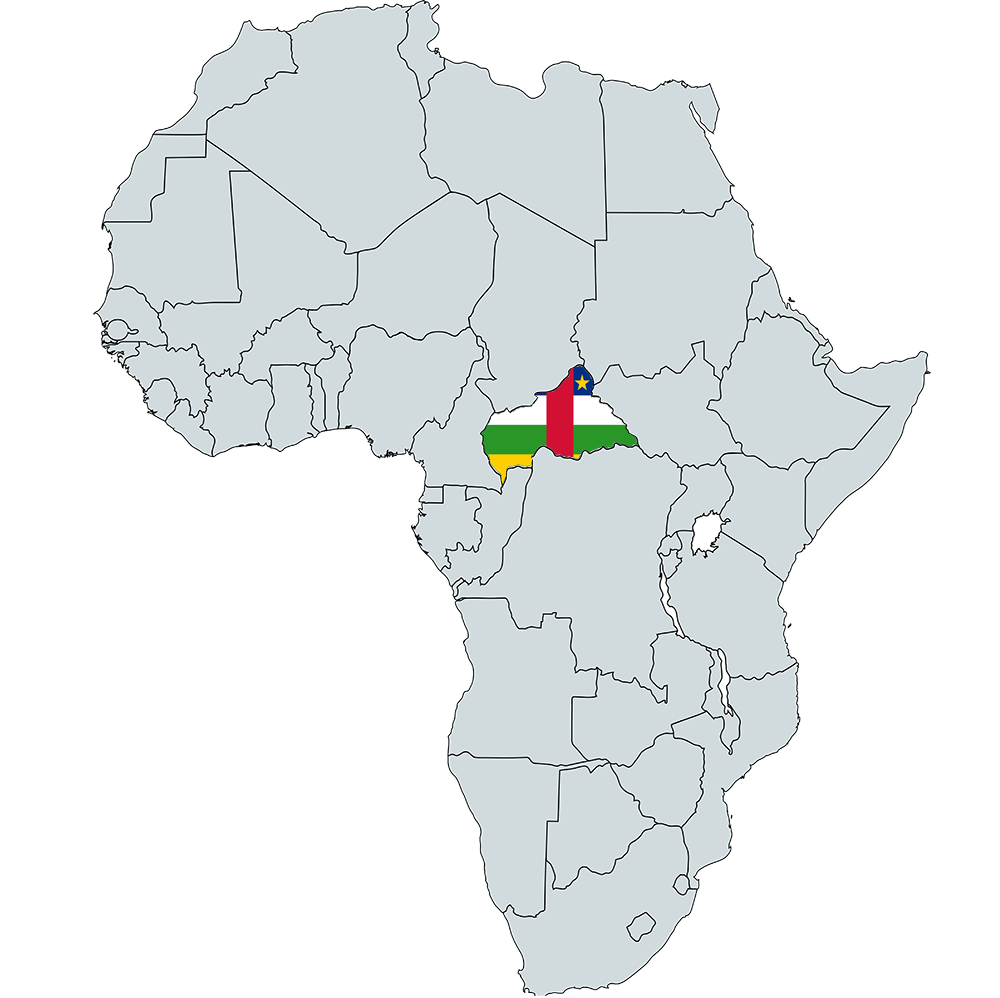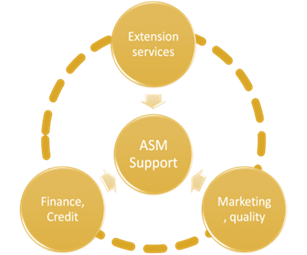
Central African Republic ASM Profile Political Economy & Strategic Standpoints | Social and Environmental Factors | Local linkages | ASM Sites in Central African Republic
CAR benefits from geological diversity giving the country an important mining potential. Gold and Diamonds are mined through artisanal methods. Regardless of the activity’s lower efficiency compared to large scale mining, CAR’s annual diamond production ranks 10th globally and 5th in terms of diamond quality. However, despite the mining industry’s potential it only contributed to 4% of the GDP.
Gold is located in the South West in Sosso-Polipo, Moboma, North in Bogoin-Toropvo, Center at Gaga-Yaloké, Roandji, Pouloubou and close to the Cameroonian border. The totality of Diamonds is produced from alluvial deposits from Grès Crétacés, Carnot-Berberati and Mouka-Ouadda. Gold and diamonds from CAR have long been associated with conflict, rebel armed groups, human rights violations and illicit financial flows (IFFs). It is estimated that over 110 000 people work in ASM of which 5% are women and 10% children. Their discovery compared to other African countries is more recent dating to the beginning of the 20th century. It wasn’t long after the precious metal’s discovery that it surpassed natural resources such as cotton, rubber or coffee in terms of exports.
Due to the informal nature of ASM in CAR a substantial part of the revenues from the activity evade legal economic channels making the activity unprofitable for the government. Export earnings are dominated by diamond sales (40%) and forestry revenue (16%).
Country Mining Vision Status
CMV Processes Underway.
Policies, Laws and Regulations Currently in Effect
Central African Republic Mining Code, 2009
ASM Associations or Cooperatives
I. UNCMCA: Union Nationale des Coopératives Minières Centrafricaines (National Union of Mining Cooperatives)
II. COOPEC: Coopératives d’Epargne et de Crédit (Savings and Credit Cooperative)
ASM Definition Criterion
Nationality; level of mechanization; Operation’s depth; ROM
ASM Licensing
Artisanal: YES
Small Scale Mining: YES
ASM Minerals or Metals Exploited
Precious Metals Gold
Base Metals Nickel, Quartz, Cobalt, Uranium, Manganese, Granite, Phosphate, Tantalite
Precious Stones Diamonds
Development Minerals Iron ore, Copper, Zinc, Lead, Titanium, Chrome, Rare Earths
Mining Code Provisions for Women in ASM
No indication or provisions regarding women
Mineral Policy of CAR
Issues: Fraud and illegal trade of diamonds
Policy Objective: Increase the mining sector’s contribution to the economy and national development
Policy provisions:
I. The Government will attract international investment in diamond mining operations;
II. The Government will regulate buying and export houses; and
III. The Government will encourage nationals of CAR to assume the role of diamond collectors such that CAR nationals and the government benefit in a fair way from the export of minerals.
Mining Policy Environment:
CAR has struggled with political instability since its independence in 1960. The current government of CAR established reform of the mining sector as a high priority soon after coming to power on March 15, 2003. The reform process was initiated in 2003 and triggered by the recognition of the poor performing mining sector and prevalence of fraud. The mining act focuses on mechanisation of the sector and promoting industrial mining. The government has enacted a decree that allows the LSM to purchase the ASM production (especially Diamond) on the condition that LSM do not expel the ASM working in their licensed areas.
The mining code promotes artisanal miners in general. Despite some efforts in ASM, gaining access to a mining license remains costly. Due to years of political and security instability acquiring data surrounding ASM and controlling the activity remains challenging. Overall, the mining policy and regulations uphold safeguards for the natural environment, acknowledge customary property rights and mandates a rationally structured mining administration apparatus to implement and manage the system.
ASM SUPPORT TRIANGLE

Finance and credit
General support is provided for ASM. This is done through the establishment of a special fund for promotion of mining (Fonds de promotion minière) in 1988 which is known today as the Compte d’affectation spécial diamant (CASDOR). This paved the way for a program on savings and loans cooperatives Coopératives d’Epargne et de Crédit – COOPEC) targeting the mining sector. Later on in 1995, the PASMA (Projet d’assistance au secteur minier artisanal) project which provides assistance to miner was implemented. The same year saw the creation of an international diamond stock exchange with the explicit intention of facilitating financing available to ASM.
Extension services - a phased approach to integration and capacity-building
Under the CAR Mining Act of 2009 artisanal miners are encouraged to form cooperatives. The national union of CAR mining cooperatives UNCMCA was responsible for almost the entire share of diamond production. The artisanal and small-scale operators see organization as a means of creating better trading conditions this encompasses certification and access to international markets.
Marketing and quality
CAR is a member of the Kimberley Process diamond certification scheme initially created to combat the trade of conflict diamonds. The licensed Import-Export Purchasing Office, Mineral buying offices constitute the final link in the country’s mineral supply chain. The Comptoir des Minéraux et Gemmes (COMIGEM) is a state-owned mineral buying office which was legalised under the 2009 Mining Code. It has experienced considerable difficulties and consequently cannot compete with private buying offices. It is estimated that 93.75% of miners sell to individual collectors.

